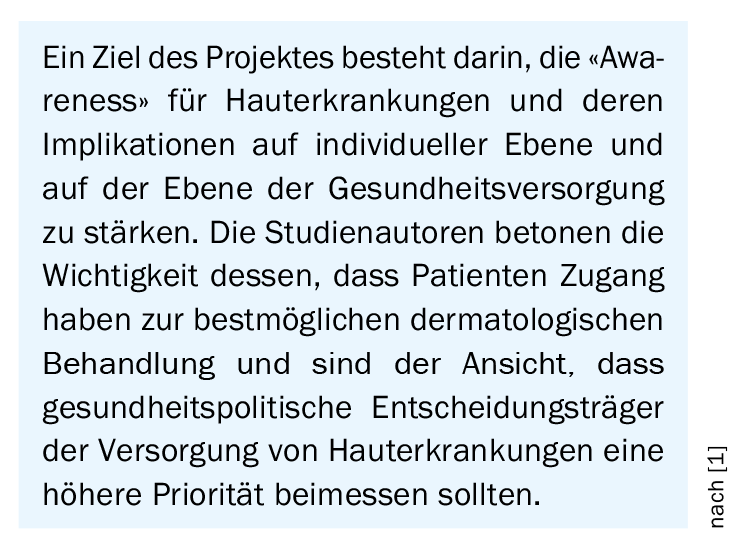In a large-scale population-based survey study conducted by the European Academy of Dermatology and Venereology (EADV), nearly one in two participants reported having been affected by at least one skin condition in the past 12 months. The data were collected from more than 44,000 adults from 27 countries in Europe; in addition to the EU countries, Norway, the United Kingdom and Switzerland were also included.
The EADV commissioned the survey to assess the prevalence of dermatologic and venereologic diseases in Europe and to learn more about the care and perception of skin diseases [1]. Prof. Marie-Aleth Richard, MD, PhD, Hôpital de la Timone, Marseille (F) led the project. According to the survey results published in JEADV, the percentage of those who suffered from at least one skin disease in the past 12 months out of a total of 44 689** included persons was 43.35% (n=19 915). Of these, 35.38% had one skin disease, 24.32% had two, 14.06% had three, and 26.34% had four or more. The mean was 3.04 ± 3.23 (median 2.00) skin diseases. If skin cancer screening was included in the analysis, the proportion of those affected was several percentage points higher (47.20%).
** 48.97% male, 51.03% female
Large representative sample
Data collection was performed by a polling institute (HC Conseil, Paris) [1]. Using a randomized proportionally stratified approach, a representative sample of the total adult (over 18 years old) population was recruited in each of the included countries. Data from Eurostat and the United Nations on sociodemographic weighting criteria (e.g. age, gender, education) were used as a reference. The selected people were asked by e-mail to participate in a survey without specifying the topic. This reduced the risk of self-selection bias.

The web-based questionnaire translated into different languages consisted of two modules: (A) sociodemographic information and general health status, (B) Skin disease during the past 12 months. Part B included questions on stigma, burden of disease, quality of life (DLQI), health care, among others. Statistical analyses were performed using the HARMONIE 1.7 software package.
What skin diseases are the most common?
Overall, fungal skin infections topped the list at 8.9%, followed by atopic dermatitis/eczema (5.5%), acne (5.4%), alopecia (5.1%), and psoriasis (3.9%) (Table 1) [1]. Alopecia, acne, eczema, and rosacea were more common in women, while men were more likely to have psoriasis and sexually transmitted infections. In the 18-25 age group (n=5543), acne (13.5%), fungal skin infections (9.5%), and sexually transmitted diseases (6.6%) were the three most common conditions, while in the 26-54 age group (n=23,593), skin infections also topped the rankings, followed by atopic dermatitis/eczema (6.5%) and acne (6.4%). Among those ≥55 years of age (n=15 553), skin infections accounted for 7.9%, while fungal skin infections accounted for 4.1% and alopecia/hair loss for 4.0%.

The study authors point out that when considering the present results, it should be borne in mind that prevalence data on skin diseases collected by means of questionnaire survey/self-report tended to be lower than when physicians were asked about them. Good agreement between self-assessments and third-party assessments by dermatologists was shown in a previous analysis regarding psoriasis, hidradenitis suppurativa, and vitiligo [1,2]. In contrast, underestimation of frequency by self-reported data was found for skin diseases such as acne, eczema, fungal skin infections, psoriasis, and seborrheic dermatitis [1,3].
A methodological strength of the study is certainly the very large representative sample [1].
Sources:
- Richard MA, et al: JEADV 2022; 36(7): 108-1096.
- Phan C, et al: Acta Derm Venereol 2017; 97: 1243-1244.
- Jagou M, et al: Br J Dermatol 2006; 155: 1006-1012.
DERMATOLOGY PRACTICE 2023, 33(2): 17











